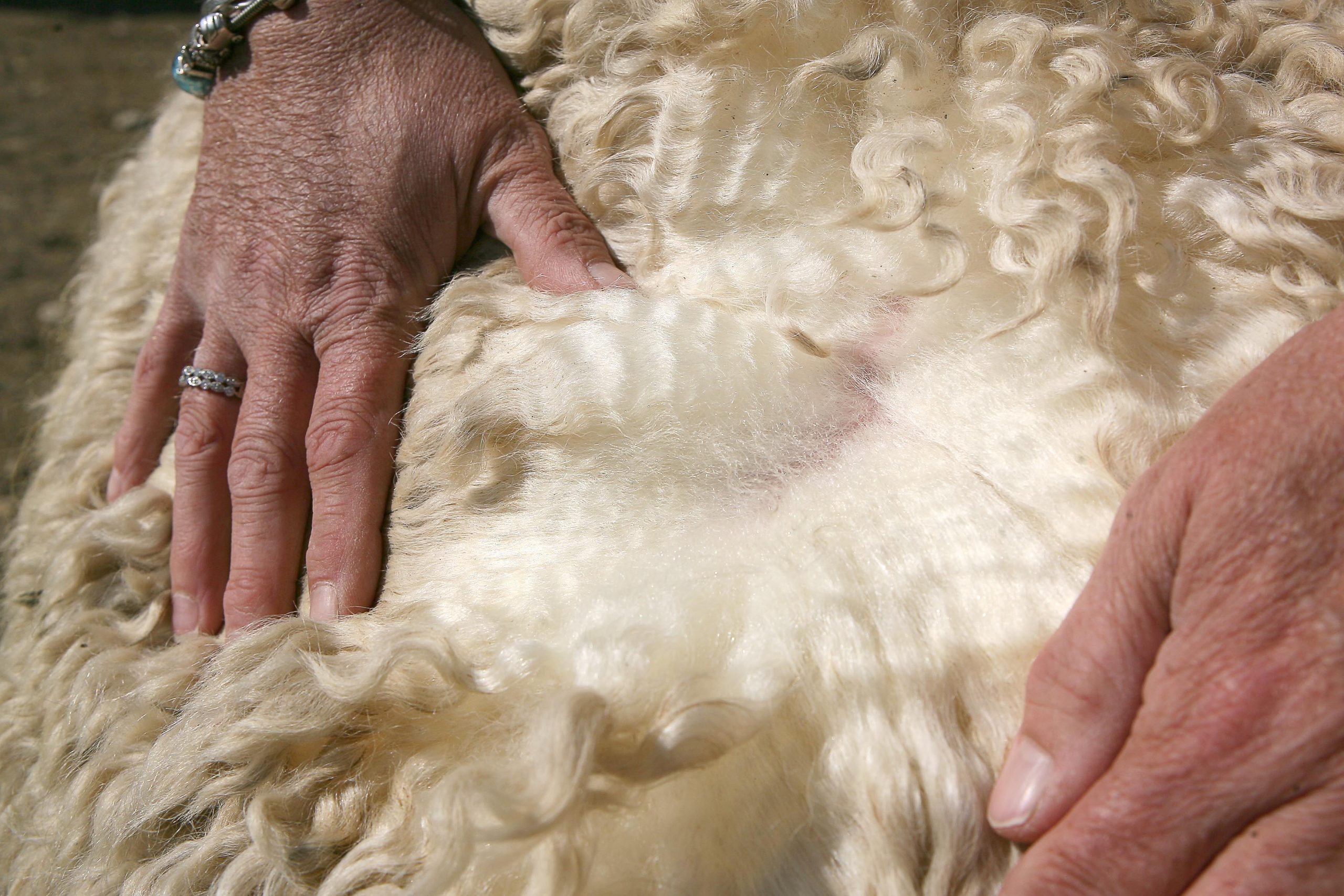To stay or shed?
Passionate strong wool growers need patience to stand the test of time whilst shedding sheep flaunt their more attractive financials. Wool prices still need to move higher again before farmers can bank a profit from their wool clip, but the tables are turning at last - what will you choose? Words Tony Leggett.

The recent lift in strong wool prices fuelled a burst of interest from a few wool farming enthusiasts who were keen to know how the Wiltshire-cross flock lined up against a heavy fleeced Romney flock with the clean price of strong wool fleece breaking through the $3/kg barrier.
But the recent surge in price for strong wool has likely been offset by increases in onfarm costs.
Massey University animal scientist Professor Steve Morris says he regularly fields phone calls and receives emails from farmers on both sides of the wool ‘divide’.
Morris is behind the trial at Massey University’s Riverside Farm, 10km north of Masterton, which is in its fourth year of grading up from a 400-head flock of Romney ewes. Current funding, provided by the LA Alexander Trust and Massey Foundation, runs out mid-2026.
He says the wool price would need to rise a further 50% to match the ‘breakeven’ price generated from modelling work carried out in 2018.
Morris says the aim of the trial was to consider if there was any loss in overall performance from grading up to a Wiltshire flock, rather than just looking at wool production and the impact of self-shedding genetics on wool profitability. “We didn’t set out to say that if you grade up to a full Wiltshire, that is a better performing sheep,” he says.
Based on the data gathered in the four years to date, Morris says apart from less wool production and the discounted price received for store male lambs, the overall performance of the grading-up Wiltshire flock matches the base flock of Romneys at Riverside Farm.
‘This trial continues to produce more feedback from farmers than any other sheep trial I’ve been involved with in my 40-plus year career. Once the trial is completed in 2026, actual data will be run through the model to see how the numbers stack up.’ – Professor Steve Morris, Massey University
This includes liveweight of lamb produced to weaning, ewe hogget and ewe fertility and fecundity, and susceptibility to worm challenge based on faecal egg counts. A mini analysis of meat yield also showed ½ and ¾ Wiltshire-cross lambs were able to produce equal amounts of saleable meat of the Romney lambs.

Data is being collected on feet scores and teeth wear as the flock ages, and pelt quality information is also collected at slaughter for analysis. The meat quality work will also be extended to see how the 15/16th Wiltshire-cross lambs compare.
Professor Morris is not surprised by the focus on wool price when farmers ask about the trial.
Before setting it up, he was involved in a 2018 project commissioned by Merino New Zealand to create a computer model to investigate the impact of introducing Merino genetics into North Island hill country strong wool flocks.
Using the limited shedding sheep performance data they could source at the time, and knowing it would take 12-15 years to create a fully shedding graded up flock with a typical age distribution, the Massey team used the same model to compare the two flocks. It showed the net present value of a fully graded-up flock was 7% higher than the base Romney flock, based on a $2.15/kg greasy wool price.
When they ran a sensitivity analysis through the model, it showed the strong wool price would need to rise to $4.15/kg greasy before farmers were better off staying with strong wool production.
Morris says he and his colleagues knew they had to dig deeper to discover more about the performance of shedding sheep. “We thought we should do this trial to get some numbers because if farmers are going to make a change, they want some hard numbers to base their decision on.”
‘We estimate the ‘tipping point’ where staying with strong wool makes financial sense is likely to be approaching $6/kg.’ – Professor Steve Morris, Massey University
Morris says he can totally understand that strong wool farmers are excited to see prices rise to $3-plus/kg clean, but he says costs have risen considerably since then too and he estimates the ‘tipping point’ where staying with strong wool makes financial sense is likely to be more than $5/kg greasy now and “could be approaching $6/kg”.
A good example of farms moving to shedding sheep flocks is Massey’s associated property Limestone Downs at Port Waikato where shearing costs were $100,000 in the last financial year and wool income totalled $60,000.
“A Maori Incorporation up the East Coast was in touch recently asking about the shedding trial. Their motivation was exactly the same as at Limestone Downs where wool harvesting costs are well above the return for the wool.”
Shearers are becoming harder to get and they require a safe place to work in.

Think about the number of wool sheds that will need to be replaced or renovated in the next few years to meet the required standards for shearers to operate in them. “If you had to replace an old woolshed on a big station you could be up for $1m, so that is a big consideration for some owners,” Morris says.
He also believes shedding sheep could have a place for smaller hill country properties where a couple are running 2,000-3,000 stock units and one person is already working off farm to support the business. Moving to a shedding sheep may allow the other person to work off farm, maybe part-time, if there is limited wool to worry about.
“I don’t know where the industry goes, maybe if it went 50% shedding then maybe the other 50% of strong wool has a more profitable future.”
Professor Morris says the only time the two flocks at Riverside are separated is for a two-cycle mating. He was surprised at the noticeable discount buyers forced when the three-quarter Wiltshire male lambs were sold at weaning last year when they were the same liveweight as the straight Romney lambs. “They do look leggier, but we have done a small comparison of boning out Wiltshire-cross lambs and Romney lambs and there is no difference in yield of saleable meat at slaughter.”
What about a change in shearing policy?
With further increases in shearing costs over the past year, farmers staying with wool growing sheep are considering the frequency of harvesting wool to offset further losses.
An analysis by BakerAg published in March 2023 investigated a 1,000ha farm with 3,400 mixed age and two-tooth ewes and 1450 ewe hoggets, producing 31,500kg of wool per year.
It noted personal preferences, debt levels, attitude to risk, the state of infrastructure on the farm, feed levels, climatic factors and sheep breed will all have an influence.
It compared six-month, eight-month and full year shearing and concluded that many factors will influence the decision to change policy.
It noted personal preferences, debt levels, attitude to risk, the state of infrastructure on the farm, feed levels, climatic factors and sheep breed will all have an influence.
Tipping point to shedding could be near
Central North Island farm consultant Peter Keeling has noticed a sharp rise in the number of Wiltshire rams in use on farms in his patch over the past five years.
He is unsurprised by the appeal of shedding sheep breeds especially given the heavy financial losses showing up in annual accounts when direct harvesting costs and the extra labour costs required to maintain a strong wool growing flock are considered.
He says the interest in shedding sheep genetics is building, but the numbers are still small overall and often in patches of the country where a few early adopters have established flocks and nearby farmers follow. “It was the same with the exotic sheep that arrived in New Zealand back in the nineties. There were lots of farmers who said they would never farm them and look at the situation now where there are millions of composite sheep being farmed these days,” Keeling says.
“Farmers learned to live with the look of those breeds and we now appreciate what the Finn and Texel genetics offered our national flock. It will be the same with the shedding sheep breeds like Wiltshire, Dorper and Australian Whites.”
He’s not surprised by the strong interest among farmers in the results of the trial at Riverside, but says a large percentage of farmers will always resist changing to shedding sheep because they are optimistic about the future of strong wool or fear changing will ruin decades of sheep breeding.
“What I’m seeing now is more prudent and pragmatic decision making going into buying shedding breed rams. Initially, there were farmers who were just so fed up with weak wool prices they were just going to have some Wiltshires on their farms, regardless of their quality.”
But now there are more options available and more pressure on stud sheep breeders to deliver performance recorded rams that will handle NZ’s hills.
He runs a small flock of shedding sheep on his own property near Te Kuiti and says he has not been asked to produce a financial assessment of how shedding sheep compare to breeds such as Romney or Coopworth for any of his clients who have or are thinking of making the switch.
“I’m one of those farmers who went for shedding sheep because they are easy-care, less work and still produce great lambs.”
He admits there are some subtle differences in the way he farms his Wiltshire sheep compared to the breeds he ran previously.
They muster differently and the crossbreds partially shed their wool so they still require shearing for less return than the wool sheep.
“I’ve also heard farmers say truck drivers don’t like partially shedding lambs dropping wool in their trucks or meat companies saying the same about sheep arriving for slaughter in their plants.”
He finishes all his male lambs and cull-ewe lambs so is not exposed to the store market where Wiltshire cross lambs are often heavily discounted by stock agents and farmer buyers.
He predicts there will be a period of steady slow growth in demand for shedding sheep genetics while farmers observe how they are performing, and consider if the move is right for them, before a more concerted surge in uptake.
Keeling says there are several ram breeders emerging with relatively new, recorded flocks of shedding sheep, who are building up their numbers and improving the quality of their stock.
‘It’s not until you have no wool that you begin to appreciate how much work you were doing: dagging, dipping, shearing, and all the mustering and bringing sheep to the yards that you don’t
need to do anymore.’ – Peter Keeling, farm consultant
“The wool value chain would need to achieve a wool price target of $7-$10/kg greasy or we’ll continue to see more and more farmers choosing shedding sheep genetics.”
The analysis included allowances for the impact each shearing policy has on production, both positive and negative.
At the time, with wool prices languishing at around $1.50/kg average, the modelled farm was losing $30,000 a year from a second-shear policy. To breakeven, the average wool price would have to hit $2.45/kg.




